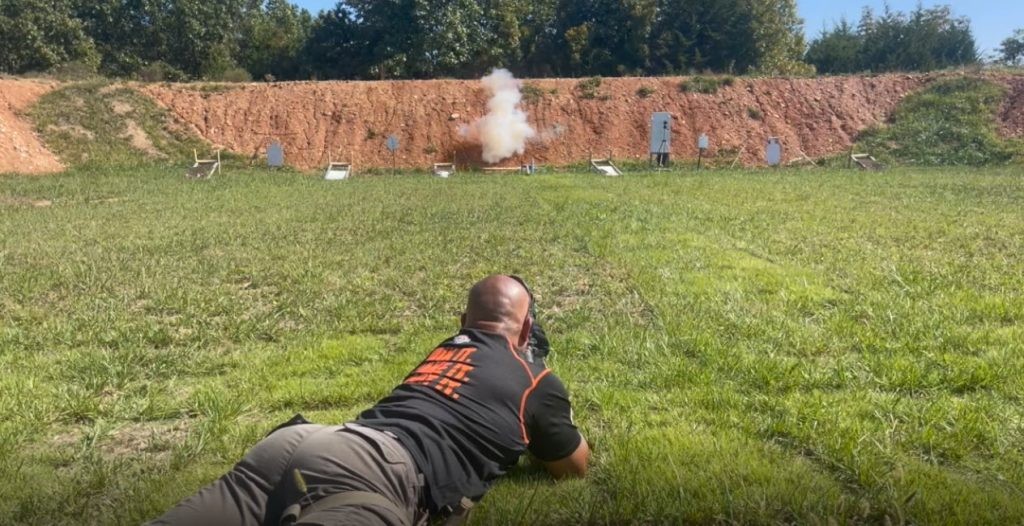Tannerite is a brand of binary explosive targets used for firearm practice, providing visual and auditory feedback upon a successful hit. At WHAT.EDU.VN, we offer clear explanations about reactive targets like Tannerite, exploring their composition, applications, and safety considerations. Delve into the realm of energetic materials and shooting sports with our comprehensive resource.
Table of Contents
- What is Tannerite and How Does It Work?
- What is Tannerite Made Of? The Chemical Composition
- What is Tannerite Used For? Applications and Purposes
- What are the Benefits of Using Tannerite?
- What are the Safety Precautions When Using Tannerite?
- What are the Legal Regulations Regarding Tannerite?
- What Types of Firearms and Ammunition are Compatible with Tannerite?
- What is the Shelf Life and Storage of Tannerite?
- What are Some Common Misconceptions About Tannerite?
- What are the Alternatives to Tannerite for Reactive Targets?
- FAQ About Tannerite
1. What is Tannerite and How Does It Work?
Tannerite is a brand name for a binary explosive target, primarily used as a shot indicator for firearms practice. These targets are designed to produce a loud report and a cloud of smoke when struck by a high-velocity bullet, providing immediate feedback to the shooter. Unlike traditional targets, Tannerite offers an interactive experience, making target practice more engaging.
The key to Tannerite’s functionality lies in its binary composition. It consists of two separate components: an oxidizer (typically ammonium nitrate) and a fuel (usually aluminum powder or a similar metallic powder). These components are non-explosive when kept separate. It’s only when they are mixed according to the manufacturer’s instructions that the mixture becomes capable of detonation.
When a high-velocity bullet impacts the mixed Tannerite target, the kinetic energy of the bullet creates sufficient heat and pressure to initiate a rapid chemical reaction. This reaction causes the mixture to detonate, producing a loud bang and a visual cloud of vaporized material. The speed and force required for this reaction mean that only rifle rounds traveling at a high velocity (typically above 2,000 feet per second) will reliably detonate Tannerite.
The use of Tannerite is primarily recreational, allowing shooters to instantly confirm successful hits and adding an element of excitement to target practice. However, it’s essential to handle and use Tannerite responsibly, adhering to all safety guidelines and legal regulations.
2. What is Tannerite Made Of? The Chemical Composition
The chemical composition of Tannerite is a crucial aspect of understanding how it functions and the safety considerations involved. As a binary explosive, it comprises two main components that are inert and non-explosive on their own but become a detonable mixture when combined.
-
Oxidizer: The primary component is typically ammonium nitrate (NH4NO3). Ammonium nitrate is a chemical compound widely used in fertilizers and explosives. In Tannerite, it acts as an oxidizer, providing the oxygen necessary for the rapid combustion of the fuel component.
-
Fuel: The second component is usually a metallic powder, most commonly aluminum powder. Aluminum powder is highly flammable and, when mixed with an oxidizer like ammonium nitrate, creates a powerful explosive mixture. Other metallic powders, such as magnesium, may also be used to enhance the explosive effect.
The specific ratio of oxidizer to fuel is carefully formulated to ensure reliable detonation when struck by a high-velocity bullet. This ratio is proprietary to the Tannerite brand, but generally, it involves a high percentage of ammonium nitrate to metallic powder.
It’s important to note that the individual components of Tannerite are not classified as explosives on their own. It is the combination and mixing of these components that creates the explosive mixture. This is why Tannerite is sold as a “binary explosive” – requiring the user to mix the two components on-site, just before use.
Understanding the chemical composition of Tannerite is essential for safe handling, storage, and use. Users should always follow the manufacturer’s instructions for mixing and handling the components to prevent accidental detonation or other hazards.
3. What is Tannerite Used For? Applications and Purposes
Tannerite, primarily designed as a shot indicator, has found its niche in various applications related to firearm activities. Its primary purpose is to provide immediate feedback to shooters during target practice, but its use extends beyond simple recreational shooting.
-
Shot Indicator: The most common use of Tannerite is as a shot indicator. When a bullet traveling at a sufficient velocity strikes the target, it detonates, producing a loud report and a cloud of smoke. This audible and visual feedback instantly confirms a successful hit, eliminating the need to walk downrange to check the target.
-
Recreational Shooting: Tannerite adds an element of excitement and engagement to recreational shooting. The explosive reaction provides a more dynamic and satisfying experience compared to shooting at static paper targets.
-
Training Purposes: Some firearms instructors and shooting ranges use Tannerite in training exercises. The immediate feedback helps shooters improve their accuracy and shot placement. It can also be used to simulate real-world scenarios where immediate confirmation of a hit is crucial.
-
Hunting Practice: Although not typically used during actual hunts, Tannerite can be used for practice sessions to simulate the adrenaline and sensory experience of taking a shot at game.
-
Special Effects: While not its intended purpose, Tannerite has been occasionally used in movie productions or special events to create explosive effects. However, this use is highly regulated and requires proper permits and expertise.
-
Gender Reveal Parties: Tannerite has gained popularity in gender reveal parties, where the explosion reveals the baby’s gender through colored smoke. However, this application has raised safety concerns due to misuse and potential for accidents.
It is essential to emphasize that Tannerite should only be used for its intended purposes and in accordance with all safety guidelines and legal regulations. Misuse of Tannerite can lead to serious accidents, injuries, or legal consequences.
The popular Tannerite reactive rifle targets for firearm practice.
4. What are the Benefits of Using Tannerite?
Using Tannerite as a reactive target offers several benefits, particularly for firearms enthusiasts and those involved in shooting sports. These benefits range from improved training feedback to enhanced recreational shooting experiences.
-
Immediate Feedback: Tannerite provides instant audible and visual feedback when a target is hit. This eliminates the need to visually inspect the target after each shot, saving time and effort.
-
Enhanced Training: The immediate feedback allows shooters to adjust their aim and technique more effectively, leading to faster improvements in accuracy and precision. It’s particularly useful for long-range shooting where visual confirmation of hits can be challenging.
-
Engaging Experience: Tannerite adds an element of excitement and engagement to target practice. The explosive reaction makes shooting more dynamic and enjoyable, which can help maintain interest and motivation during training sessions.
-
Versatile Application: Tannerite can be used in various shooting disciplines, including rifle practice, long-range shooting, and tactical training. It can also be used with different types of firearms and calibers, as long as the ammunition meets the velocity requirements.
-
Cost-Effective: Compared to some other types of reactive targets, Tannerite can be a cost-effective option for providing dynamic feedback during shooting sessions. Its relatively low cost per target makes it accessible to a wide range of shooters.
-
Convenient: Tannerite is sold as a binary explosive, meaning the components are non-explosive until mixed. This makes it easier to transport and store compared to traditional explosives.
-
Safety: When used correctly and according to the manufacturer’s instructions, Tannerite is a relatively safe product. Its binary nature reduces the risk of accidental detonation during storage and handling.
Despite these benefits, it is crucial to emphasize that Tannerite must be used responsibly and in compliance with all safety guidelines and legal regulations. Failure to do so can result in serious accidents, injuries, or legal consequences.
5. What are the Safety Precautions When Using Tannerite?
Safety is paramount when using Tannerite or any other type of explosive target. Due to its explosive nature, Tannerite poses potential risks if not handled and used correctly. Strict adherence to safety precautions is essential to prevent accidents, injuries, and property damage.
-
Read and Follow Instructions: Always read and carefully follow the manufacturer’s instructions for mixing, handling, and using Tannerite. These instructions provide critical information on safe usage and potential hazards.
-
Wear Protective Gear: Always wear appropriate protective gear, including eye protection (safety glasses or goggles) and ear protection (earplugs or earmuffs). These will help protect against flying debris and the loud noise produced by the explosion.
-
Use in a Safe Location: Use Tannerite only in a remote and unpopulated area, away from buildings, roads, and other structures. Choose a location with a clear line of sight and a safe backstop to contain any projectiles or debris.
-
Maintain a Safe Distance: Maintain a safe distance from the target when shooting. The manufacturer’s instructions will specify the minimum safe distance, which typically ranges from 100 yards for smaller targets to 200 yards or more for larger targets.
-
Mix Only When Ready to Use: Mix Tannerite only when you are ready to use it. Do not mix it in advance and store it, as this increases the risk of accidental detonation.
-
Use Appropriate Ammunition: Use only high-velocity rifle ammunition that meets the manufacturer’s specifications for detonating Tannerite. Handguns and shotguns are not suitable for use with Tannerite.
-
Elevate the Target: Place the Tannerite target on a stable platform or elevate it slightly off the ground. This can help reduce the amount of ground debris and improve the visibility of the explosion.
-
Avoid Flammable Materials: Do not use Tannerite near flammable materials, such as dry grass, brush, or gasoline. The explosion can generate heat and sparks that could ignite these materials.
-
Be Aware of Fire Hazards: Be aware of the risk of fire, especially in dry conditions. Have a fire extinguisher or water source nearby in case of accidental ignition.
-
Respect Local Laws: Be aware of and comply with all local laws and regulations regarding the use of explosive targets. Some areas may have restrictions or prohibitions on their use.
-
Store Properly: Store Tannerite components in a cool, dry place, away from heat, sparks, and open flames. Keep them out of reach of children and unauthorized individuals.
By following these safety precautions, you can significantly reduce the risk of accidents and injuries when using Tannerite. Always prioritize safety and use common sense when handling explosive materials.
6. What are the Legal Regulations Regarding Tannerite?
The legal regulations surrounding Tannerite vary depending on the jurisdiction, and it’s essential to be aware of and comply with all applicable laws before purchasing, possessing, or using it. Failure to do so can result in severe legal consequences, including fines, imprisonment, and confiscation of firearms.
-
Federal Regulations: In the United States, Tannerite is regulated by the Bureau of Alcohol, Tobacco, Firearms and Explosives (ATF). The ATF classifies Tannerite as an explosive material when the two components are combined. However, the individual components are not regulated as explosives.
-
State and Local Regulations: State and local laws regarding Tannerite can vary widely. Some states may have specific regulations on the purchase, possession, storage, and use of Tannerite, while others may have no specific laws addressing it. Some jurisdictions may require permits or licenses to purchase or use Tannerite, while others may prohibit its use altogether.
-
Transportation Regulations: The transportation of Tannerite may also be subject to regulations, particularly if transporting the mixed components. It’s essential to check with the relevant authorities to ensure compliance with all transportation laws.
-
Permissible Use: The legal use of Tannerite is generally limited to shot indication during target practice. Using Tannerite for any other purpose, such as creating explosions for recreational purposes or malicious intent, is typically illegal and can result in severe penalties.
-
ATF Rulings: The ATF has issued rulings clarifying the legal status of Tannerite and other binary explosives. These rulings provide guidance on the manufacture, distribution, and use of these products.
-
Consequences of Violations: Violating laws and regulations related to Tannerite can result in severe penalties, including fines, imprisonment, and confiscation of firearms and other property. In some cases, violations may also result in federal felony charges.
Given the complex and varying nature of laws and regulations surrounding Tannerite, it’s always advisable to consult with legal counsel or local law enforcement agencies to ensure full compliance with all applicable laws before purchasing, possessing, or using Tannerite.
7. What Types of Firearms and Ammunition are Compatible with Tannerite?
To reliably detonate Tannerite, specific types of firearms and ammunition are required. The key factor is the velocity of the bullet upon impact. Tannerite is designed to be detonated by high-velocity rifle rounds, and it will not reliably detonate with handgun rounds, shotgun rounds, or low-velocity rifle rounds.
-
Rifle Calibers: The most common types of firearms used with Tannerite are rifles chambered in high-velocity calibers such as .223/5.56mm, .243 Winchester, .270 Winchester, 7mm Remington Magnum, .308 Winchester, .30-06 Springfield, and similar calibers. These calibers typically produce bullet velocities exceeding 2,000 feet per second, which is generally required to detonate Tannerite.
-
Bullet Velocity: The minimum bullet velocity required to reliably detonate Tannerite is typically around 2,000 feet per second (fps). However, some manufacturers may recommend higher velocities for larger targets or specific formulations of Tannerite.
-
Bullet Weight and Construction: While bullet velocity is the primary factor, bullet weight and construction can also play a role in detonation reliability. Heavier bullets and bullets with a solid or frangible core may be more effective at detonating Tannerite than lighter bullets or bullets with a hollow point.
-
Handguns and Shotguns: Handguns and shotguns are not suitable for use with Tannerite. Handgun rounds typically do not generate sufficient velocity to reliably detonate Tannerite, and shotgun rounds, even those with slugs, lack the necessary velocity and concentrated impact force.
-
Rimfire Cartridges: Rimfire cartridges, such as .22 Long Rifle, are generally not suitable for use with Tannerite. These cartridges typically produce low bullet velocities that are insufficient to initiate detonation.
-
Magnum Calibers: High-powered magnum calibers, such as .300 Winchester Magnum or .338 Lapua Magnum, are more than capable of detonating Tannerite. However, using such high-powered calibers may not be necessary or practical for recreational target shooting.
It’s essential to consult the manufacturer’s instructions for specific recommendations on compatible firearms and ammunition. Using the appropriate firearms and ammunition is crucial for ensuring reliable detonation and minimizing the risk of misfires or accidents.
Tannerite is designed to be detonated by high-velocity rifle rounds, providing visual and auditory feedback.
8. What is the Shelf Life and Storage of Tannerite?
Proper storage and awareness of the shelf life of Tannerite are essential for maintaining its effectiveness and ensuring safety. Tannerite, in its unmixed state, has a relatively long shelf life when stored correctly.
-
Shelf Life: Tannerite components, when stored in their original, unopened containers, typically have a shelf life of several years. The manufacturer, Tannerite, claims a shelf life of approximately 10 years when stored in a dry, room temperature location.
-
Storage Conditions: The ideal storage conditions for Tannerite components are a cool, dry, and well-ventilated area. Avoid storing Tannerite in direct sunlight, near heat sources, or in areas with high humidity.
-
Original Containers: Always store Tannerite components in their original containers. These containers are designed to protect the components from moisture, contamination, and accidental mixing.
-
Separation: Keep the oxidizer and fuel components separate until you are ready to mix them for use. Accidental mixing of the components can create an explosive mixture that is sensitive to impact and friction.
-
Mixed Tannerite: Once Tannerite components have been mixed, the resulting mixture should be used immediately. Do not store mixed Tannerite, as it can become unstable and pose a significant safety hazard.
-
Signs of Degradation: Inspect Tannerite components periodically for signs of degradation, such as clumping, discoloration, or a strong odor. If you notice any of these signs, do not use the components and dispose of them properly according to local regulations.
-
Temperature: Fluctuations in temperature can affect the shelf life and stability of Tannerite components. Avoid storing Tannerite in areas where temperatures fluctuate significantly.
-
Humidity: High humidity can cause the oxidizer component (ammonium nitrate) to absorb moisture, which can reduce its effectiveness and increase the risk of clumping.
By following these storage guidelines, you can maximize the shelf life of Tannerite components and ensure their safe and effective use.
9. What are Some Common Misconceptions About Tannerite?
Several misconceptions surround Tannerite, often leading to misuse or unsafe handling. Addressing these misconceptions is crucial for promoting responsible and informed use of this product.
-
Misconception: Tannerite is a High Explosive: One common misconception is that Tannerite is a high explosive, similar to dynamite or C4. In reality, Tannerite is a binary explosive that is relatively stable and requires a high-velocity bullet impact to detonate. It is not as sensitive or powerful as traditional high explosives.
-
Misconception: Tannerite Can Be Detonated with a Handgun: Another misconception is that Tannerite can be detonated with a handgun or shotgun. Tannerite requires a high-velocity rifle round to reliably detonate. Handgun rounds and shotgun rounds typically do not generate sufficient velocity or impact force to initiate the explosive reaction.
-
Misconception: Tannerite is Safe to Store After Mixing: It is a dangerous misconception that Tannerite is safe to store after the two components have been mixed. Once mixed, Tannerite becomes an explosive mixture that is more sensitive to impact, friction, and heat. It should be used immediately after mixing and never stored for later use.
-
Misconception: More Tannerite is Better: Some users believe that using larger quantities of Tannerite will result in a more impressive explosion. However, exceeding the manufacturer’s recommended limits can be dangerous and may violate local laws. Using excessive amounts of Tannerite can also increase the risk of property damage and personal injury.
-
Misconception: Tannerite Can Be Used for Any Purpose: Tannerite is designed and intended for use as a shot indicator during target practice. Using Tannerite for any other purpose, such as creating explosions for recreational purposes or malicious intent, is irresponsible, illegal, and can have serious consequences.
-
Misconception: Tannerite is Not Regulated: While the individual components of Tannerite are not regulated as explosives, the mixed product is subject to various federal, state, and local laws and regulations. It’s essential to be aware of and comply with all applicable laws before purchasing, possessing, or using Tannerite.
-
Misconception: Tannerite is a Toy: Tannerite is not a toy and should never be treated as such. It is an explosive material that requires responsible handling and strict adherence to safety precautions.
By dispelling these common misconceptions, we can promote safer and more responsible use of Tannerite and prevent accidents, injuries, and legal issues.
10. What are the Alternatives to Tannerite for Reactive Targets?
While Tannerite is a popular choice for reactive targets, several alternatives offer similar feedback and excitement for shooting enthusiasts. These alternatives may vary in terms of composition, sensitivity, and legal regulations.
-
Other Binary Explosive Targets: Several other brands of binary explosive targets are available on the market. These products typically consist of an oxidizer and a fuel that are mixed on-site to create an explosive mixture. Examples include products from vendors other than just Tannerite.
-
Frangible Targets: Frangible targets are made from brittle materials that shatter upon impact, providing visual feedback to the shooter. These targets are typically made from clay, ceramic, or other non-explosive materials.
-
Self-Healing Targets: Self-healing targets are made from a resilient polymer material that reforms after being hit by a bullet. These targets provide visual feedback in the form of a temporary hole or indentation.
-
Steel Targets: Steel targets, also known as gong targets, produce an audible “ring” when hit by a bullet. These targets are durable and can be used repeatedly, making them a cost-effective option for long-term use.
-
Water-Filled Targets: Water-filled targets consist of containers filled with water that rupture upon impact, creating a splash effect. These targets are relatively safe and environmentally friendly.
-
Electronic Targets: Electronic targets use sensors to detect bullet impacts and provide immediate feedback to the shooter via a display screen. These targets can track shot placement and provide scoring information.
-
Paint-Filled Targets: Paint-filled targets are containers filled with paint that splatter upon impact, providing visual feedback to the shooter. These targets are often used in paintball and airsoft games.
When choosing an alternative to Tannerite, it’s essential to consider factors such as cost, availability, safety, legal regulations, and the type of feedback desired. Some alternatives may be more suitable for certain shooting disciplines or environments than others.
Remember, regardless of the type of target used, safety should always be the top priority. Always follow the manufacturer’s instructions and adhere to all applicable laws and regulations.
FAQ About Tannerite
Here are some frequently asked questions about Tannerite, addressing common concerns and providing helpful information for users:
| Question | Answer |
|---|---|
| What type of round do I need to use to detonate Tannerite? | Tannerite brand targets need to be hit solidly with a transonic round. A transonic round is one going 2,000 feet per second or faster. Larger diameter bullets work better than smaller ones. |
| What are some common rounds that work with Tannerite? | .223/5.56mm NATO, 5.45x39mm, 6mm Remington, .243 Winchester, .270, 7.62x39mm, 7mm Remington Magnum, .300 Savage, .308/7.62mm NATO, .30-06, .300 Remington Magnum, .338 Remington Magnum, .50 Browning. |
| What is the shelf life of Tannerite? | Tannerite brand targets are meant to be stored in a dry, room temperature location and can last about 10 years. |
| What is the recommended range distance when shooting Tannerite? | Place ¼, ½, and 1 lb targets down range at least 100 yards before shooting. Place 2 lb targets 200 yards down range before shooting. |
| What is the legal use of Tannerite? | Legal use of these targets is as a shot indicator ONLY. Do not mix over 2lb per shot. |
| What safety information should I be aware of when using Tannerite? | Misuse of binary targets could result in serious injuries or death. Always wear ear and eye protection, and use in a remote area away from combustible materials. Never place targets inside, on top of, or under any metal, rock, or other surfaces. |



Do you have more questions about Tannerite or other shooting-related topics? Visit WHAT.EDU.VN to ask your questions and get answers from our community of experts. Our platform offers a free and easy way to get the information you need, whether you’re a seasoned shooter or just starting out.
At WHAT.EDU.VN, we understand the challenges of finding reliable and accurate information. That’s why we’ve created a platform where you can ask any question and receive helpful answers from knowledgeable individuals. Our goal is to provide a resource that is accessible to everyone, regardless of their background or expertise.
Don’t hesitate to reach out with your questions. Our community is ready to help you find the answers you’re looking for. Visit WHAT.EDU.VN today and start exploring the world of knowledge!
Address: 888 Question City Plaza, Seattle, WA 98101, United States
Whatsapp: +1 (206) 555-7890
Website: what.edu.vn
Explore Tannerite Sports Apparel and Gifts at tanneritesports.com.
